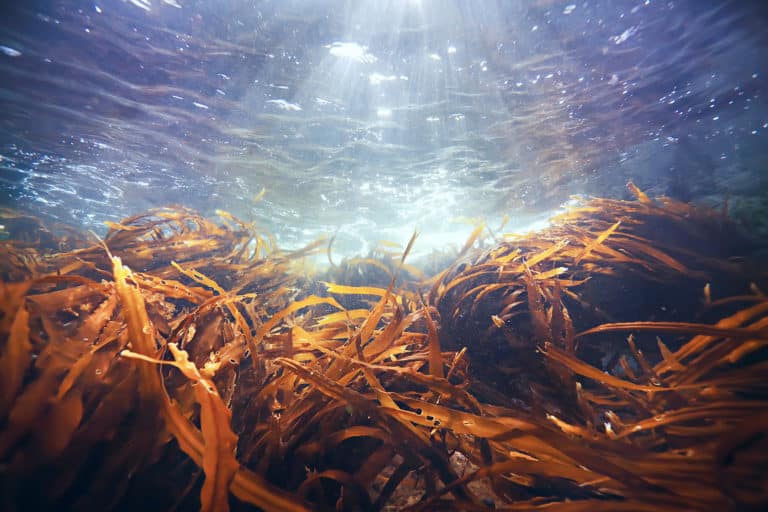Brown algae

It is estimated that about 280,000 different species of algae exist on our planet, but only about 40,000 of them are known to date. Among these, there are a few hundred species that have been phytochemically characterised. Science has already identified about 70 substances that occur in algae and have the ability to kill cancer cells. Particularly noteworthy are the so-called fucoidans, which are found in brown algae that thrive in the North and Baltic Seas. Fucoidan is a sulphated polysaccharide found in the intercellular spaces and fibrillar cell walls of brown algae and is thought to protect them from desiccation when exposed to low tide. Scientists have not yet identified fucoidan in land plants or other algae species, but it has been detected in some marine animals such as sea snails, sea cucumbers and sea urchins, where it is thought to play a role in egg fertilisation.
Brown algae in Asian cuisine
Brown algae have played an important role in Asian cuisine for centuries. In countries such as Japan and China, where the consumption of algae-containing foods is widespread, it is believed that the incidence of chronic diseases such as cancer and diabetes is lower than in Western countries. People in these regions are also less likely to be overweight and have a higher life expectancy. This is partly attributed to algae-based dietary habits. The carcinostatic effect of fucoidan on tumours has been confirmed by numerous studies. In in vitro studies, fucoidan has been shown to inhibit the growth of lymphomas and various forms of non-small cell lung cancer. This effect is based on complex interventions in the immune system (immunomodulatory). In addition, the substance has an antiviral effect directed against various viruses such as ECHO-6, poliovirus type III, coxsackie viruses type B3 and type A16, and adenovirus type III. Recent studies also suggest an antiviral effect against the enveloped cytomegaloviruses as well as HIV. In addition, anticoagulant, antioxidant, anti-inflammatory and antithrombotic activities of fucoidan have been demonstrated. It also shows promising applications in the treatment of age-related macular degeneration.
Algae in Traditional Chinese Medicine
Algae play an important role in Traditional Chinese Medicine (TCM). They are used to treat various conditions such as cough, bronchitis, tonsillitis, fever, stomach problems, arthritis, urinary tract infections and incontinence. Brown algae are also valuable sources for sophisticated cosmetics. However, depending on the species and origin, the exact effects and properties of the algae can vary. Therefore, different algae species from different regions are harvested at different times in order to examine and characterise them chemically and biologically in more detail. The cross-border project “FucoSan – Health from the Sea” is funded by the European Union under the Interreg programme (until February 2020) and supported by several companies and academic partners.
Fucoidan in cosmetic products
The effect of fucoidan on human skin was allegedly discovered by accident. A scientist came into contact with brown algae several times during her work and was then amazed to notice that minor injuries on her skin healed quickly. Fucoidan can be used in cosmetics specifically against skin ageing due to its strong antioxidant effect. It can slow the formation of skin wrinkles and improve the appearance of existing wrinkles by reducing their depth. It also slows the decline of skin elasticity. Interestingly, the anti-ageing effect of fucoidan is related to the molecular weight of the substance. High molecular weight fucoidan has been found in studies to be particularly effective in reducing wrinkle depth and suppressing wrinkles, as well as protecting skin elasticity and collagen content. Fucoidan regenerates skin cells and activates the skin’s natural ability to restore itself. It also improves various skin problems by protecting the skin’s moisture and brightening the skin. In addition, the substance forms an anti-inflammatory protective barrier.
What is fucoidan from brown algae?
Fucoidan consists mainly of sulphated L-fucose and makes up about 25 to 30 percent of the dry weight of brown algae. It is obtained by extraction with hot water, acid, or lye. The first successful extraction was achieved by the scientist Kylin in 1913 from the species Laminaria and Fucus.
Fact Sheet Fucoidan:
– INCI: Hydrolyzed F-Fucoidan
– CAS number: 9072-19-9
– Description: Hydrolysed F-Fucoidan, consisting of sulphated fucose esters, obtained by a hydrolysis process.
– Composition: mainly sulphated L-fucose (6-deoxy-L-galactose) and a minor amount of other monosaccharides
– Origin: derived from brown algae species such as Fucus vesiculosus, Macrocystis pyrifera and Undaria pinnatifida
– Effects: carcinostatic, immunomodulatory, antiviral, anticoagulant, antithrombotic, antioxidant, blood lipid level-lowering, hepatoprotective, anticomplementary, anti-inflammatory, gastroprotective
Sophisticated cosmetics with Fucoidan of the brown algae
Fucoidan is a completely natural power substance extracted from brown algae. It can not only inhibit the formation of cancer cells, but also has anti-inflammatory and antioxidant properties. This makes it an excellent ingredient for high-quality (anti-aging) cosmetics. Ask us, we will be happy to develop sophisticated products for you.
Literature
Fucoidan-Derived Functional Oligosaccharides: Recent Developments, Preparation, and Potential Applications.; Foods. 2023 Feb 18;12(4):878.
Polysaccharides from the Sargassum and Brown Algae Genus: Extraction, Purification, and Their Potential Therapeutic Applications.; Plants (Basel). 2023 Jun 25;12(13):2445.
Alginate industrial waste streams as a promising source of value-added compounds valorization.; Sci Total Environ. 2022 Sep 10;838(Pt 3):156394.